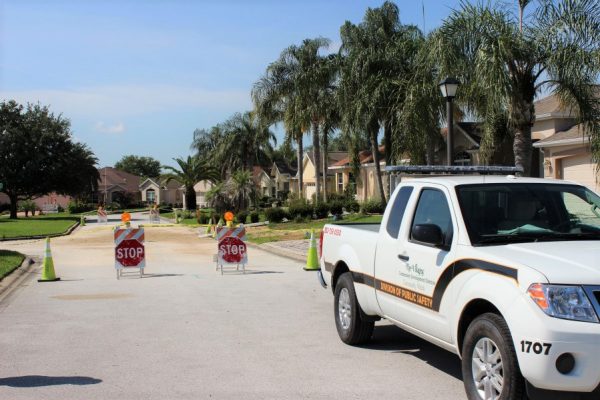One of two homes severely damaged by sinkholes more than four months ago in the Village of Calumet Grove has been deemed “structurally unstable” and “not habitable.”
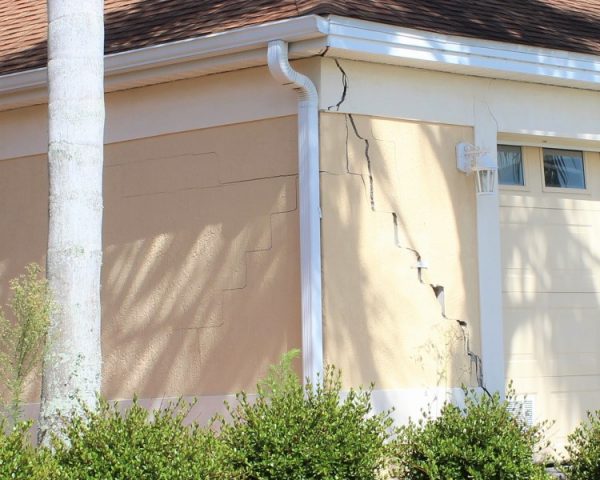
That’s according to a recent letter written by William H. Matthews of Bowen Engineering of Orlando that was sent to District and Marion County building officials June 27. Matthews sent the letter five days after visiting the damaged home owned by retired widow Doris Morrill at 17092 McLawren Terrace.
In addition to suggesting that Morrill’s home be condemned, Matthews reported seeing signs of “major settlement” of the supporting soil around the house, which has “structural distress” in several areas. He said those are signs of instability that could lead to unpredictable “imminent structure failure or collapse.”
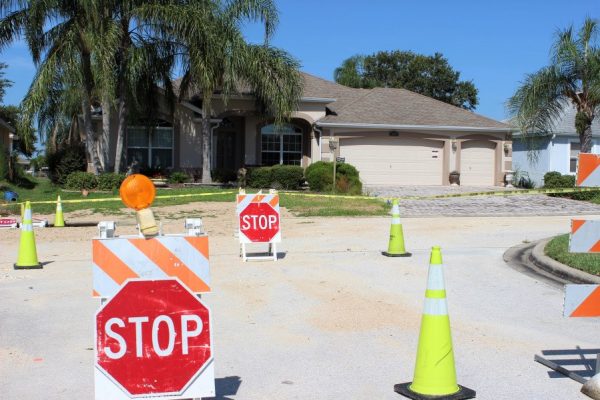
In fact, the letter concludes, the damage to Morrill’s house from the February sinkhole activity is “so extensive and pervasive” throughout the structure that repairing it would be cost prohibitive, uncertifiable and unpredictable as to the outcome, the letter says.
This week, Morrill said she couldn’t comment about her house “for legal reasons.” But she did say it’s been a frustrating situation to deal with, adding that she’s stayed with four Villagers and in a nearby rental since the February incident, which largely prompted Smithsonian Magazine in May to declare “The Villages is a hotbed of sinkholes.”
“It’s disrupting my entire lifestyle,” Morrill said. “I was expecting to have a peaceful and enjoyable retirement.”
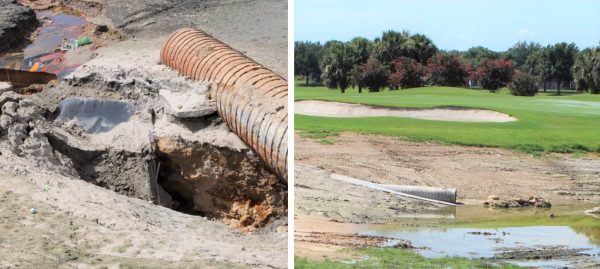
Nearby McLawren Terrace neighbor Patricia Bielicki said many who live in the immediate area feel like they’ve been ignored since the sinkholes first appeared Feb. 15 and again May 21 when four more depressions opened up.
“We are all worried,” she said. “Everybody is afraid other sinkholes are going to open up.”
Heidi Pfleger, who lives on McAlpin Street, agreed, adding this isn’t how she and her husband, Richard, planned to spend their retirement years.
“I’m concerned about something happening to our property,” she said. “The longer they are waiting to fix this situation, I think the more at risk we are.”
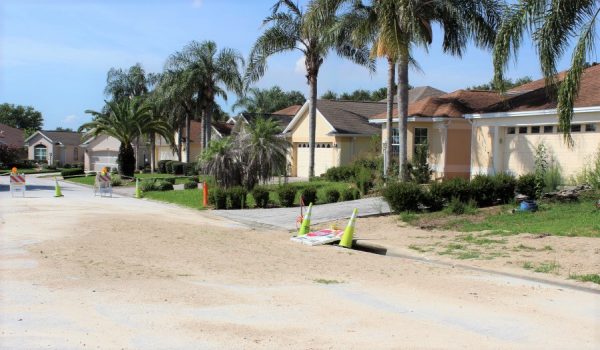
But according to Richard Baier, assistant district manager, fixing the problem hinges on the actions of different parties, including the homeowners, the developer, the District and Marion County.
The homeowners are responsible for their properties, while the developer has the retention pond behind the homes. The district is responsible for repairs to the roadway at the intersection of McLawren and McAlpin, as well as the storm water pipe that runs between the two houses and the outfall of the pipe at the retention pond on Torri Pines Golf Course. And Marion County building officials are tasked with deciding if the house is safe to live in.
As it stands now, Baier said the district can’t make repairs to the roadway and the pipeline until they are sure what’s going on with the ground underneath and beside Morrill’s house. And they really can’t do much until she takes some kind of action regarding her house, Baier added.
“We just can’t have workers or equipment in there until testing is done and it’s stabilized by the property owner,” he said. “We’ve absolutely got to make sure it’s safe.”
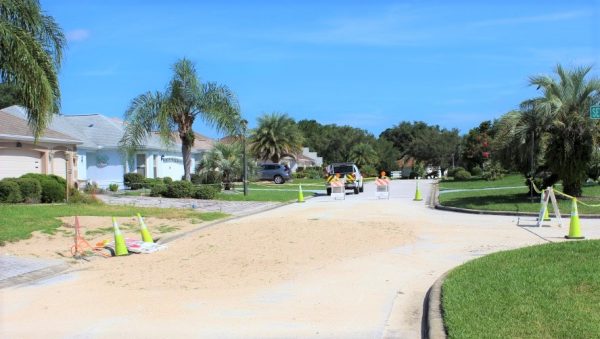
Many residents who live in the McLawren Terrace area, including Pfleger, remain suspicious about the pipe at the site of sinkholes, including where it was exposed and rose above the ground at the edge of the retention pond.
“I believe it’s due to the pond or whatever water is coming in,” Pfleger said, adding that she believes there’s been some kind of erosion along the path of the pipe as it runs into the sewer system. “I’m definitely not an engineer, but from what we’ve been seeing, that seems to be the problem.”
District officials have vehemently denied any link between the pipe and the sinkholes. Numerous reports have documented activity and damage from the sinkhole and none of the reports have found a link between the pipe and the sinkhole, Villages officials said.
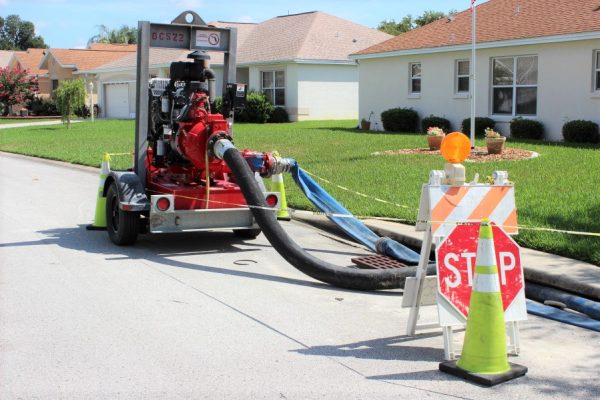
And Baier even gave a detailed presentation on the sinkholes and the pipe June 8 at the Community Development District 4 Board meeting at Savannah Center.
Pfleger said she and her neighbors also are upset because a large pump that sits on a side street is needed to remove water out of the sewer drain and onto the street when heavy rains occur. She said she was told by a neighbor who is away that she needs to call district personnel and let them know whenever it starts to rain.
But Baier said that’s not the case, as the district has a protocol in place regarding the use of the pump.
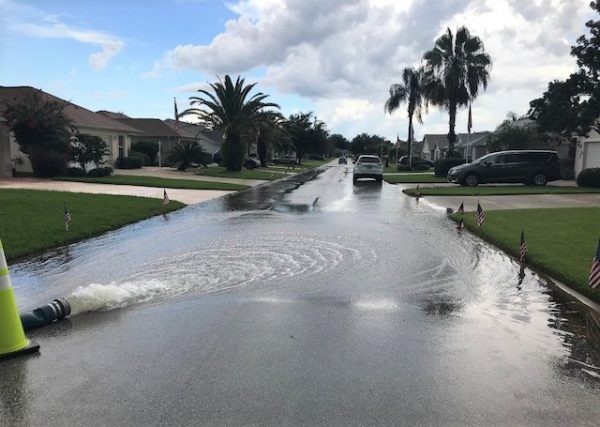
“If it’s just an afternoon shower, we’re not turning it on,” he said, adding district staff will activate the pump whenever rainfall reaches 1.5 inches or more. “It’s there to pump water basically from downstream to another (sewer drain).”
Baier added that it’s better to have storm water run down the street to a different drain than to take the chance of sending it through the pipe that can’t yet be inspected.
“We don’t want to further damage the structures,” he said.
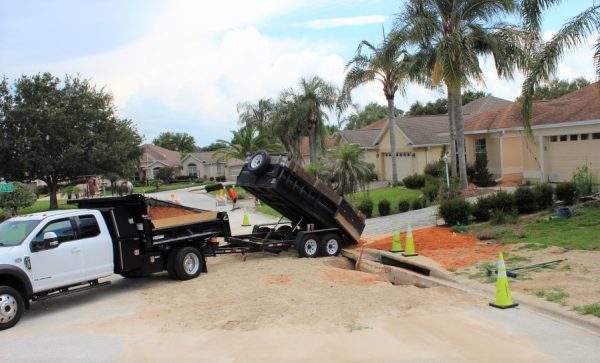
On Thursday, nerves were rattled again in the quiet neighborhood when a hole opened up in the area where the previously damaged roadway meets the curb in front of Morrill’s house and the other damaged home owned by Frank and Jan Neumann. A crew was busy filling the hole with a load of dirt as dark storm clouds appeared to the north of the neighborhood.
Baier said the issue was a washout of soil along the curb/gutter line near the drainage inlet where fill dirt has made its way into the inlet during recent storms. Baier said crews haven’t been able to make the needed repairs to the roadway because three engineering reports – two geotechnical and one structural – recommend against any further work adjacent to Morrill’s property. The reports cite the instability of her home and the property itself.
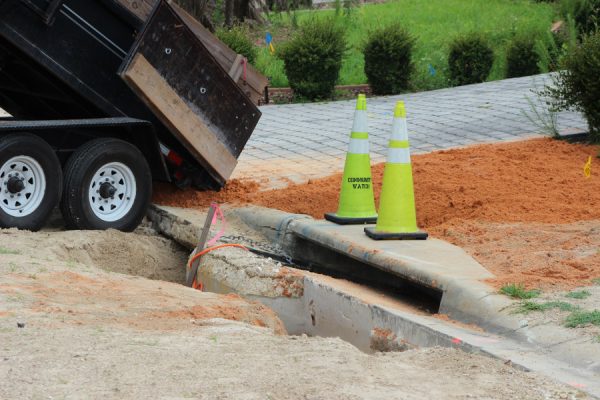
Meanwhile, Community Development District 4 supervisors know a hefty price tag – at least $560,000 in unexpected costs – is coming their way once the work on the pipes and repairing the pavement gets under way.
In fact, it was the sinkhole issue, along with a big expense for Hurricane Irma cleanup that might not be reimbursed by FEMA, that led supervisors in June to vote for a 20 percent increase in maintenance assessment – a number that possibly could be lowered when the final budget is approved in September.
“We are trying to do the best we can for the residents. We’ve got a million-dollar bogey behind us,” said CDD 4 Chairman Paul Kelly.

But that doesn’t really help the McLawren Terrace area residents who just want to get everything fixed and move on with enjoying their retirement years in Florida’s Friendliest Hometown.
“It’s just a ridiculous situation,” Bielicki said. “We can’t even drive down our street to get home.”
